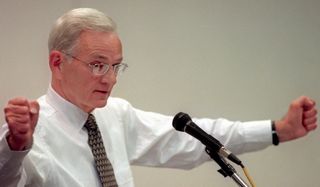Hopefully, you’ve spent some time working on your habits as
you’ve started the new year. If you’re
just joining the discussion, you may want to catch up by reading the previous posts on this topic (1,2,3).
 We’ll finish up this series by introducing the concept of a
We’ll finish up this series by introducing the concept of a
“keystone habit.” From a holistic
perspective, this concept has the greatest application to real estate organizations
and individual offices.
In his book, Charles Duhigg introduces this concept in a
chapter he calls “The Ballad of Paul O’Neill.”
If you’re a political buff, you may remember that Paul O’Neill was
Treasury Secretary during President Bush’s first term. However, he is more famous for his work as CEO of
Alcoa during the late ‘80s and ‘90s.
Here is a quick summary (as written up by Keren Threlfall
) of what happened at Alcoa:
Investors and employees alike were shocked when Paul O’Neill
shared this in his speech of acceptance as the new CEO of Alcoa:“I want to talk to you about worker safety. Every year,
numerous Alcoa workers are injured so badly that they miss a day of work. I
intend to make Alcoa the safest company in America. I intend to go for zero
injuries.”Some people thought perhaps he had a touch of dementia.
Investors called their clients and advised them to sell their stock
immediately. (Those who did so would later realize that was some pretty bad
advice.)What O’Neill was doing was introducing a keystone habit.
“O’Neill believed that some habits have the power to start a
chain reaction, changing other habits as they move through an organization.
Some habits, in other words, matter more than others in remaking businesses and
lives. These are “keystone habits,” and they can influence how people work,
eat, play, live, spend, and communicate. Keystone habits start a process that,
over time, transforms everything.”As the company focused on safety, employees and investors
were amazed at the other areas of change, as well. Alcoa eventually rose to new
heights in production, employee satisfaction, and in their portfolios, as well.By the time O'Neill retired in 2000 to become Treasury
Secretary, the company's annual net income was five times larger than before he
arrived, and its market capitalization had risen by $27 billion. Someone who
invested a million dollars in Alcoa on the day O'Neill was hired would have
earned another million dollars in dividends while he headed the company, and
the value of their stock would be five times bigger when he left.
There is a lot more to his story—more than I can write here
and stay within the reasonable bounds of a WorkPuzzle discussion. If you want to delve more into the
details, read the lengthy article
published on keystone habits in the Huffington Post last year.
There are two principles that I took away from the Ballad of
Paul O’Neil:
1. The organizational
habits that matter the most are the ones that, when they start to gain momentum,
dislodge and remake other patterns.
2. Keystone habits
encourage change by creating structures that help other organizational habits
to flourish.
As a business leader, the challenge is to identify the
keystone habit for your organization.
Obviously, it would not be appropriate to select the same one that Paul
O’Neil used (safety). Instead, look for ones that would impact your organization as described above.
Any ideas?
Here’s what I’ve noticed after working with hundreds of real
estate managers and organizations over the last seven years: the keystone habit for most real estate organizations
is recruiting.
In the years ahead, the keystone habit that will increasingly impact the real estate industry will be new agent recruiting.
Why? This is the one habit that best fits the two principles
outlined in Duhigg’s research for a real estate organization. New agent recruiting has the capacity to dislodge and remake other patterns. Also, new agent recruiting has the unique ability to encourage change through the creation of new structures.
What are your thoughts? Do you see new agent recruiting as the keystone habit that can help your organization prosper?
Bonus Materials: As we wrap our discussion on habits, you may have an interest in referencing this cool infographic on habits (some of you may remember, I really like infographics). If you're serious about changing habits, this breaks down the process and helps in the diagnosis of each stage.
Join the WorkPuzzle Discussion at the Tidemark Online Community (TMOC)
Engage in the WorkPuzzle discussion by joining the TMOC private social network. Commenting on a public blog like WorkPuzzle can be a little intimidating, so why not join the discussion inside the privacy of the TMOC discussion group?
By joining TMOC, you'll get to see who else is in the group and your comments will only be seen by those whom you trust. Joining TMOC is quick, easy, and free (no kidding…this takes less than 2 minutes). To get started, click here.
Already of a member of TMOC? If so, join the WorkPuzzle Dialog Group by clicking on the WorkPuzzle Group icon on the left side of your TMOC homepage. Questions? Email the WorkPuzzle editor (workpuzzle@hiringcenter.net) and we'll walk through the process.
 Editor's Note: This article was written by Ben Hess. Ben is the Founding Partner and Managing Director of Tidemark, Inc. and a regular contributor to WorkPuzzle.
Editor's Note: This article was written by Ben Hess. Ben is the Founding Partner and Managing Director of Tidemark, Inc. and a regular contributor to WorkPuzzle.

